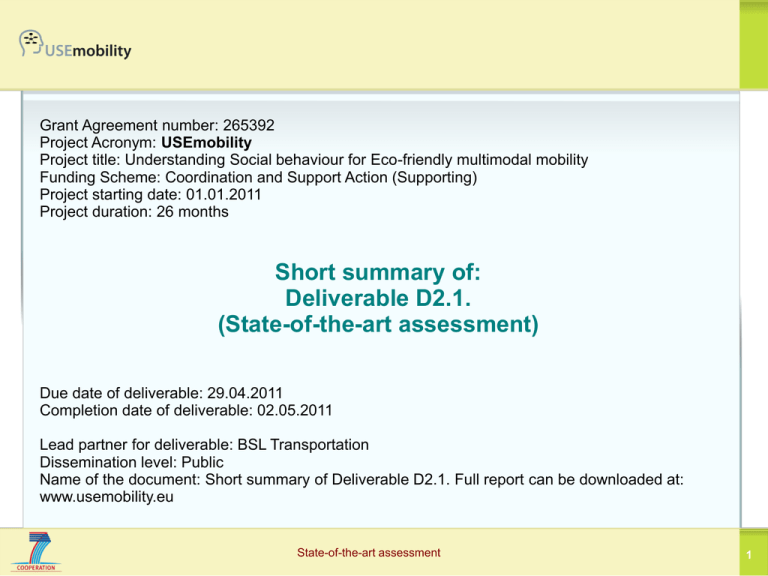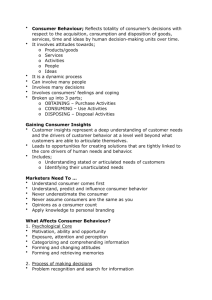State of the art assessment - short presentattion
advertisement

Grant Agreement number: 265392 Project Acronym: USEmobility Project title: Understanding Social behaviour for Eco-friendly multimodal mobility Funding Scheme: Coordination and Support Action (Supporting) Project starting date: 01.01.2011 Project duration: 26 months Short summary of: Deliverable D2.1. (State-of-the-art assessment) Due date of deliverable: 29.04.2011 Completion date of deliverable: 02.05.2011 Lead partner for deliverable: BSL Transportation Dissemination level: Public Name of the document: Short summary of Deliverable D2.1. Full report can be downloaded at: www.usemobility.eu State-of-the-art assessment 1 Management Summary Key Findings Theoretical basis Meta study Fostering the potential The knowledge about theoretical models of systems dynamics, social behaviour and consumer behaviour lead to a better understanding of mobility behaviour. The meta study of European and national studies of five countries showed a focus on objectively measurable and individual factors, mainly examining small sample sizes on national basis. . Mobility behaviour can be influenced and thus changed by transportation companies and politics. There is a trend towards multimodality by the younger generation. To foster this potential, decision makers need to consider a bundle of internal and external factors, influencing the mobility decision. Implication for USEmobility Learnings from theory The theoretical models provided knowlege about the dynamics and complexity of transportation systems,interference mechanisms, factors influencing the mobility decision and behaviour at different decision processes. Need for USEmobility USEmobility aims to fill the gap of an European internationally comparable large-sample survey, focusing on social factors and multimodality with the objective of developing target group-specific recommendations for decision makers. Recommendations USEmobility recommendations need to adress two target groups, on the one hand to keep And intensify the use of existent users and on the other hand to get non-users of multimodality into the system.The core of USEmobility measures is a change in multimodal offer characteristics and a change in attitudes, emotions, perception and knowledge of potential customers. State-of-the-art assessment 2 EXCELDATEIPFAD.xls Overview 1. Theoretical Background 2. Meta Study 3. Systems Theory Social Behaviour Models Consumer Behaviour Models Comparison Quantitative Analysis Need for USEmobility Conclusion State-of-the-art assessment 3 Systems Theory shows possibilities of influencing the dynamic transportation system DESCRIPTION EVALUATION System Border Options for interference Where? Technology, networks, the link characteristics (interfaces), the vehicles, the system operating policies, the organizational policies and the travel or other activity options Elements (e.g. passengers, transport modes) IMPLICATION FOR USEMOBILITY Peripheral System (e.g. political, legal, economic, social system) Impact on? Users, Operators, Physical, Functional, Governmental Level Complex systems are often beyond a linear cause-effect scheme. Recommended measures need to be adapted to the different countries Systems Theory shows that the transportation system is a complex, dynamic, real and open system, which is embedded in a peripheral system. The system can be influenced from outside. State-of-the-art assessment 4 Social Behaviour Models show that rational explanations of mobility behaviour are not sufficient DESCRIPTION EVALUATION Rational-Choice Model • wrong subjective perception of costs • individual utility maximization • no applicability of the rational choice approach for leisure-related journeys • cost–benefit ratio: costs and time spent Low Cost Thesis • Attitudes and moral beliefs are especially relevant when perceived ‚cost‘ of a specific behaviour are low • Mobility behaviour is regarded as a „high cost area“ Theory of Planned Behaviour • Attitudes, social expectations and the perceived difficulty influence the mode choice • Conflicting studies about the applicability of the low cost thesis for different travel purposes IMPLICATION FOR USEMOBILITY A strict rational approach, considering only time and costs, towards mobility behaviour is not adequate and other explanations are necessary. Significant influence of attitudes, expectations and the perceived difficulty, especially in uncertain and intransparent situations, which should be included in the USEmobility recommendations Norm-Activation Model • Internal and external factors influence the mode choice • Considers awareness of problem and its consequences, subjective norm/moral values, perceived difficulty and objective characteristics of the offer • USEmobility needs to consider both, internal and external factors, focusing on social factors of mobility behaviour • Objective characteristics and subjective perception need to be considered State-of-the-art assessment 5 Consumer Behaviour Models emphasize the complexity of the mobility behaviour decision process DESCRIPTION Consumer behaviour describes the behaviour of people at the purchase and consumption of economic goods - behavioural approach instead of „homo oeconomicus“ S Stimuli O Organism R Response S = Stimuli (marketing-stimuli, environmentstimuli) – can be directly observed O = Organism (cognitive and activation processes, attitudes as well as presdisposed factors such as culture, involvement and reference groups) – can not be directly observed R = Response (Brand Selection, Point of Purchase, Amount of purchase, Expense) – can not be directly observed Shell model of consumer behaviour distinguishes between psychological, personal, social and cultural determinants EVALUATION IMPLICATION FOR USEMOBILITY Consumer behaviour models show that within the organism a complex decision process takes place. Psychological, personal, social and cultural determinants need to be considered when developing recommendations influencing mobility behaviour. Consumer behaviour theory differ between decisions with greater cognitive control (extensive and limited) and decisions with low cognitive control (habitual and impulsive) - dependent on the type of selected product, the purchase situation or other determinants, such as the risk attitude or the involvement. There are different types of mobility decisions, dependent on the travel purpose (work, leisure). The measures need to be adapted. Specific target groups should be adressed with the measures. The public transport sector could learn a lot from other industries (e.g. automotive industry) where the model is already examined very well and where specific target customers are determined. State-of-the-art assessment 6 Overview 1. Theoretical Background 2. Meta Study 3. Systems Theory Social Behaviour Models Consumer Behaviour Models Comparison Quantitative Analysis Need for USEmobility Conclusion State-of-the-art assessment 7 Meta Study • Analysis of 70 European and national studies • In-depth-analysis and comparison of 18 high-relevance studies from Austria (3), Croatia (2),Germany (7), Hungary (2), Belgium (2) and Europe (2), examined by Sample Size Research Method Geographical Range Contents Multimodality focus Group differentiation …showed the need for USEmobility State-of-the-art assessment 8 The comparison shows that social behaviour has rarely been examined in a large sample with primary research State-of-the-art assessment 9 The comparison shows that most studies have a national focus and rarely examine multimodality State-of-the-art assessment 10 The comparison shows that studies differ among sociodemographic groups and focus on objective or offerrelated factors State-of-the-art assessment 11 The quantitative analysis of 18 studies identifies objective and personal factors as main drivers for the mode choice Number of Answers Costs/Income 4 Structural aspects 3 Attractiveness of offer 3 car/license availability 10 11 4 12 6 10 8 1 7 8 5 physical ability information/knowledge 4 Parking problems, congestion 4 attitudes 4 social reputation 3 friendliness 3 perceived safety/security 3 habits/experiences 3 2 flexibility 4 stress accidents 2 age 2 Change of the personal situation 2 Household features 14 9 environment comfort 14 very important important 1 State-of-the-art assessment 12 The comparison and the quantitative analysis of the studies showed the need for USEmobility Objective factors and personal situation form a corridor Objectively measurable factors such as costs, travel time and infrastructure play an important role when it comes to mobility decisions. Together with the individual situation, that is characterized by car availability, income, employment, household size, mobility restrictions and socio-demographic features, they form a framework or a ’corridor’, in which the mobility decision takes place. USEmobility tries to find out what happens within this corridor. Consideration of social factors Situational factors and social behavioural factors such as attitudes and opinions, experiences,habits and environmental awareness need to be considered, which have been neglected in the past. Recent mobility behaviour studies could identify the importance of attitudes and individual Attitudes as significant factor aspects for the mode choice, which are not covered by traditional mode choice models such as the rational choice approach. Attitudes showed the highest significance when distinguishing among different mobility groups! State-of-the-art assessment 13 EXCELDATEIPFAD.xls Overview 1. Theoretical Background 2. Meta Study 3. Systems Theory Social Behaviour Models Consumer Behaviour Models Comparison Quantitative Analysis Need for USEmobility Conclusion State-of-the-art assessment 14 Conclusion Trends towards an increase in the use of public transport, especially for younger Trend towards multimodality generations, mainly due to environmental concerns and the life in urban centers, show a high potential for an increased multimodal mobility in the future. Internal personal factors (human individual), external personal factors, physical ability, Bundle of Factors situational factors and offer-related factors can be distinguished when examining mobility behaviour. A change towards eco-friendly mobility The studies show that changes in mobility behaviour are possible. Possibilities of influencing the system There are different possibilities to change the system. Influencing the multimodal offer The results will finally enable policy, transport operators, civil societies, such as passengers’ associations and other decision makers to systemically influence mobility behaviour. according to customers' needs and a change in attitudes, emotions, perception and knowledge of the users are in the focus of USEmobility. State-of-the-art assessment 15 EXCELDATEIPFAD.xls The core of USEmobility recommendations are offerrelated and social changes, adressing two target groups 1 Change in multimodal offer characteristics, corresponding to the desires and demands of the potential customers Core of USEmobility Less emigration of passengers out of the system Users of multimodality (frequent or occasional) Increase of use of multimodal transport alternatives Possibilities of system inteventions How to keep users in the system and to make them intensifying their use? 2 Change in attitudes, emotions, perception and knowledge of potential customers through changed characteristics of the offer 3 Change in characteristics and communication of the multimodal offer, corresponding to the personal and physcial abilities 4 Change in characteristics and communication Non-Users of multimodality Change from monomodal to multimodal mobility How to get nonusers into the system? of the multimodal offer to adapt to possible situational influences 5 Change in communication, legal an lobbyistic activities with the objective of building a better framework for multimodal mobility offer vs. Monomodal mobility offer State-of-the-art assessment 16




